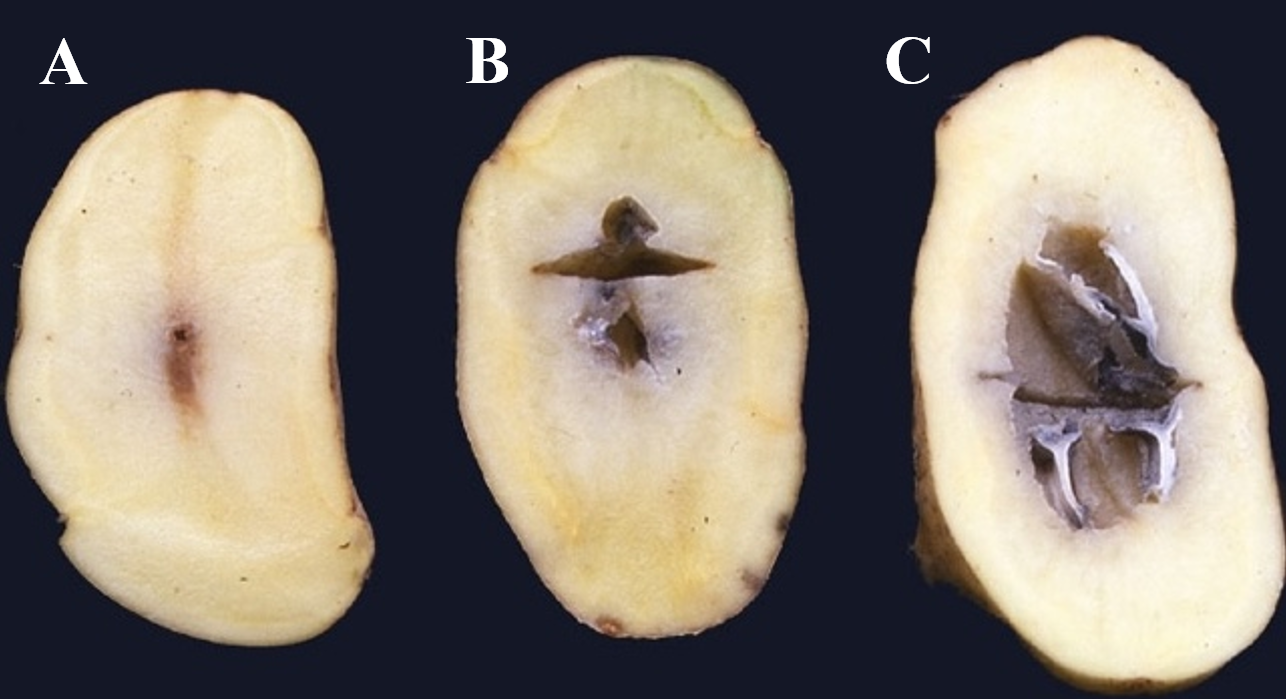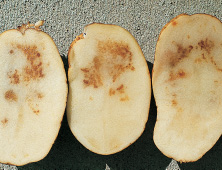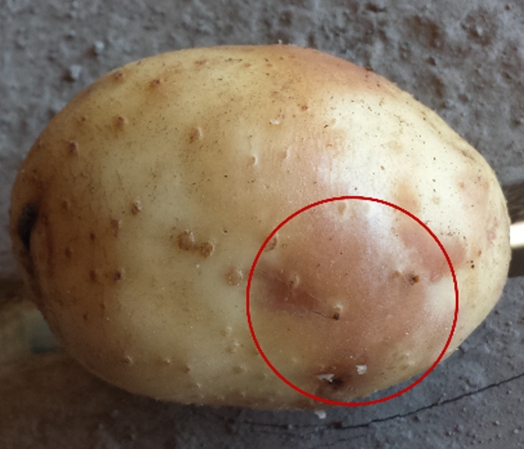
In This Issue:
- End of season crop production comments
- Potato tuber heat necrosis and hollow heart
- Late blight updates for potato/tomato
- Cucurbit downy mildew updates
- Pink eye of potato
Yi Wang, Associate Professor & Extension Potato and Vegetable Production Specialist, UW-Madison, Dept. of Plant and Agroecosystem Sciences, 608-265-4781, Email: wang52@wisc.edu.
Since it is close to the end of the field season, growers reported that overall, it is an average year for most vegetable crops. Summertime warmth returned this week, with daily max temps topping 80°F and weekly averages several degrees above normal. Precipitation totals were light for most of the week, with less than 0.5’’ common throughout most parts of the state. Most soil moisture data collected from the UW research farms saw a decline in the top 4’’, with the latest NASS report indicating increases in the percentage of topsoil that is dry to very dry.
The next 7 days are expected to be more active for rainfall statewide, with multiple rain chances anticipated during early next week. Climate outlook for late September suggests an increased likelihood (70-80% chance) for warmer-than-normal conditions. However, the outlook for October does not show any strong signs of above or below normal conditions.
In recent weeks, I received some growers’ questions about seeing a higher incidence of hollow heart and heat necrosis on some varieties. Both hollow heart and heat necrosis are physiological defects caused by environmental stresses during the growing season. Both can result in significant losses in crop quality and economic returns for growers.

Hollow heart (above), depending on its severity, is also called brown center. Brown center is a milder form of hollow heart. A brown discoloration without a visible flesh separation in the pith region of the tuber is known as brown center (a). The brown coloration results from inadequate mineral and carbohydrate concentrations in the affected tissues that reduce cell membrane integrity. Tubers are mostly susceptible to brown center during the period from tuber initiation through early tuber bulking. Soil temperatures below 55°F for 5 to 7 days during early tuber development can initiate brown center.
Available soil moisture levels above 80 to 85% during early tuber bulking can also increase the incidence of brown center, possibly due to the slower warming of wet soils.
Hollow heart (b, c) is characterized by the formation of an irregular cavity in the flesh of the tuber, usually surrounded by dark brown tissues. The cavities can vary widely in size and can form in the center of the pith or near the stem or bud ends of the tuber, depending on when the disorder occurs.
There are two types of hollow heart, namely early and late initiation types. Early initiation appears shortly after tuber set and is caused by the same factors that cause brown center. Rapid tuber bulking results in the cavitation of the damaged tissues, which is often associated with a period of restricted tuber growth caused by cool soil temperatures, followed by accelerated growth rates as the temperature warms up. Excessive nitrogen availability during tuber initiation may increase the incidence of early initiation hollow heart by producing a large canopy that competes with tubers for nutrients and carbohydrates, and by cooling the soil through shading of the soil surface.
Late initiation hollow heart occurs during the latter part of the tuber bulking period and is not usually associated with a brown center. It is most commonly caused by a growth stop due to soil moisture or temperature stresses, followed by a return of favorable conditions and rapid tuber growth. In this process, cell division resumes but follows a different direction, causing the tuber interior to split and an internal gap to form.
Previous data show that before row closure, nitrogen fertilization rates above 200 lb/acre and available soil moisture above 80-85% field capacity (FC) can significantly increase the incidence of brown center and hollow heart. Therefore, during the early season, smaller dose of nitrogen applications and keeping the soil moisture between 65 and 80% FC are good to reduce brown center and hollow heart. Calcium application is also helpful in providing the cell walls with strength and rigidity, and reducing these defects. During the later season, informed irrigation and fertility management are generally good.
Brown center and hollow heart will NOT occur after vine kill, because vine kill stops tuber growth.

Heat necrosis is also referred to as internal brown and internal necrosis, which is characterized by small, brown, necrotic lesions or spots inside the vascular ring of the tuber (Figure on the left). It should be noted that heat necrosis differs from brown center in that it does not concentrate in the pith of the tuber, but instead appears as diffuse spots randomly distributed in the tuber flesh. Heat necrosis could begin to develop shortly after tuber initiation. But more commonly, it becomes more severe during late tuber bulking and senescence, or even after vine kill. Symptoms also tend to intensify during storage under warm temperatures. Research has found a relationship between the development of this defect and a lack of adequate calcium in the tuber. Hot, dry weather and high soil temperatures and fluctuating soil moisture conditions during tuber bulking are also associated with the incidence and severity of heat necrosis. In sandy soils that have low cation exchange capacities and higher conductance of heat, it can be more prevalent. Some varieties, such as Atlantic, Yukon Gold, and Russet Burbank, are susceptible to heat necrosis.
Supplying sufficient irrigation during hot and dry periods is helpful to reduce heat necrosis. Adequate calcium in the tuber-forming zone in the sandy soil or low calcium soil is also a good cultural practice to prevent this defect.
Amanda Gevens, Professor & Extension Vegetable Pathologist, UW-Madison, Dept. of Plant Pathology, 608-575-3029, gevens@wisc.edu
Late blight of potato/tomato. I’m aware of no new reports of late blight in the US this past week. Findings thus far in potato and tomato have been confirmed as US-23 Phytophthora infestans (still sensitive to mefenoxam/metalaxyl (ie: Ridomil) in western NY and Ontario Canada. Here in Wisconsin, we saw limited accumulations of 2-5 DSVs across WI this past week. https://agweather.cals.wisc.edu/vdifn?model=late-blight Please find a fungicide listing for Wisconsin potato late blight management: https://vegpath.plantpath.wisc.edu/documents/potato-late-blight-fungicides/
For custom values of P-Days (for Early Blight) and DSVs (for Blitecast for Late Blight), please explore the UW Vegetable Disease and Insect Forecasting Network tool for P-Days and DSVs across the state (https://agweather.cals.wisc.edu/vdifn). This tool utilizes NOAA weather data. Be sure to enter your model selections and parameters, then hit the blue submit button at the bottom of the parameter boxes. Once thresholds are met for risk of early blight and/or late blight, fungicides are recommended for optimum disease control. Fungicide details can be found in the 2025 Commercial Veg. Production in WI Extension Document A3422: https://cropsandsoils.extension.wisc.edu/articles/2025-commercial-vegetable-production-in-wisconsin-a3422/
Cucurbit Downy Mildew: No downy mildew was seen on cucurbits this past week at HARS, and none reported through our UW Plant Disease Diagnostic Clinic. There were no new reports of downy mildew on cucurbits through the Cucurbit Downy Mildew ipm PIPE website: https://cdm.ipmpipe.org/.
Pink Eye of Potato or Periderm Disorder Syndrome:

Pink eye is characterized by a short-lived external pink color that is often, but not always, found around the potato eyes of freshly harvested tubers. Eyes at the bud ends of tubers (i.e., those farthest from where tubers are attached to stems) more commonly show pink eye symptoms. Pink eye can eventually develop into corky patch/bull hide, which involves a thickening of areas of tuber skin extending approximately 1/10 of an inch into the tuber flesh. Corky patch/bull hide can make tubers unmarketable for either fresh market or processing.
External pink eye symptoms are often accompanied by brown patches in the tuber flesh immediately underneath the skin. Browning due to pink eye can resemble browning due to other disorders such as internal brown spot or heat necrosis, but these latter disorders tend to occur deeper in the tuber (i.e., inside the vascular ring), rather than just underneath the skin.
It is not uncommon to see pink eye with other tuber diseases or disorders including Potato Virus Y, bacterial soft rot, and elephant hide or periderm damage from excessive water or salt toxicity.
Pink eye can also be confused with late blight (see UW Plant Disease Facts D0068, Late Blight). If there is any question whether the problem might be late blight rather than pink eye, contact your county Extension agent for information on submitting a sample to a diagnostic lab for proper testing.
Where does pink eye come from?
Pink eye is a physiological disorder (i.e., an abnormality in plant growth), rather than a true disease that involves a disease-causing microorganism. Pink eye arises during periods of excessive soil moisture and warm temperatures, especially during the later stages of tuber development. Pink eye symptoms typically appear within seven to 10 days after excessive rain. Excessive soil moisture coupled with high soil temperature causes a lack of oxygen around potato tubers, leading to damage of cells in the tuber skin. This cell damage contributes to pink eye development. Environmental conditions that lead to pink eye also promote tuber infections by the pathogens that cause Pythium leak, bacterial soft rot (see UW Plant Disease Facts D0010, Bacterial Soft Rot), pink rot, and Fusarium dry rot (all diseases associated with pink eye in storage).
How do I salvage potato tubers affected by pink eye?
Once pink eye symptoms develop, they are permanent. If symptoms are minor, tubers may still be usable. However, when pink eye symptoms are severe, symptomatic tubers will be rejected and discarded.
How do I avoid problems with pink eye in the future?
Growers have no control over the extreme precipitation and high temperatures that promote pink eye development. However, growers can practice management strategies that minimize water-saturated soils and reduce warm soil temperatures, thus reducing the severity of pink eye.
To minimize water-saturated soils, deep till areas where pink eye has been a problem, areas where water tends to collect for extended periods, and areas where soils may be compacted (e.g., field entrances or head lands). Deep tillage will break up subsoils in these areas that impede proper drainage during wet weather. Proper drainage will limit periods when tubers will be oxygen deprived and thus more prone to pink eye development. Also, avoid any activities that will cause soil compaction such as operation of heavy and large farm tractors and other field equipment when soils are wet. Minimizing water-saturated soils will not only reduce the likelihood of pink eye development but will also help limit development of other tuber diseases.
To promote cooler soil temperatures, be sure to manage diseases (e.g., potato early dying) that reduce canopy coverage. Loss of canopy allows soils to warm faster on sunny days, thus leading to higher temperatures that are more favorable for pink eye development.
Finally, be sure to scout for pink eye symptoms prior to and during harvest. Knowing the severity of pink eye in a field can help growers make informed decisions about the appropriate duration for tuber storage and the best end use for symptomatic tubers.
For more information on pink eye:
Contact the University of Wisconsin Plant Disease Diagnostics Clinic (PDDC) at (608) 262-2863 or pddc@wisc.edu.
PDDC fact sheet: https://pddc.wisc.edu/wp-content/blogs.dir/39/files/Fact_Sheets/FC_PDF/Pink_Eye_of_Potato.pdf